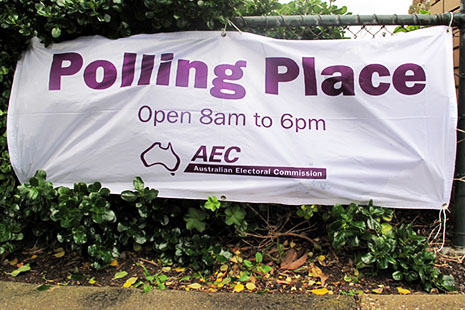The Australian Voter: 50 Years of Change
By Ian McAllister | UNSW Press | $49.95
THE Australian voter has been busily filling ballot boxes for more than a century, but how much do we know about this ubiquitous figure towards whom all manner of enticements, blandishments, appeals and fears are directed? Or, to pose the question another way: what does the behaviour of the voter tell us about who we are and what we believe?
Despite the legal requirement to attend a polling place and cast a ballot every few years, research tells us that this civic obligation is worn lightly; broadly speaking, the voter is not well-informed. Nor has the voter changed much, apart from irregularly rotating parties in government; indeed, a pervasive obstinacy on the part of the voter has steadfastly resisted constitutional change, with a mere eight proposals, most of them minor, passed out of forty-four propositions put.
Millions of dollars are spent in pursuit of the voter, seeking to influence, cajole and seduce; countless hours are spent probing his or her attitudes through endless focus groups and interminable opinion polls. To get inside the voter’s mind is the political equivalent of finding the Holy Grail. Who, then, is this voter?
Professor Ian McAllister of the Australian National University has spent decades poring over the Australian voter, examining predilections, preferences and prejudices in the most minute detail – most notably through the invaluable Australian Election Study, a detailed survey conducted after every federal election since 1987. Through the lens of his political scientist’s microscope he has found a perplexing figure, riddled with contradictions, inconsistencies and plain cantankerousness.
To illustrate these bewildering tendencies, McAllister quotes Don Aitkin on the issue of compulsory voting, a far from common feature among the family of democratic nations. Compulsory voting, writes Aitkin, is “precisely the kind of authoritarian relationship that the Australian of myth and legend might be expected to jib at.”
The unprecedented expansion of higher education over the past six decades might reasonably have been expected to produce a greater degree of political sophistication and critical engagement with the system, but it seems we are still influenced very strongly by the political orientation of our parents, although not as much as we once were.
The same can be said for knowledge of matters political. The surveys show that the great majority of voters “know relatively little about politics and possess minimal factual knowledge about the operation of the political system.” As depressing as this might be – and there are no signs it is changing – it is in line with international findings. Not unexpectedly, the least well-informed tend to be the young and people with low levels of education, and political knowledge is closely related to age, birthplace, gender and occupation – factors that have long been in evidence. These findings are disturbing, as McAllister notes, if a prerequisite for a robust representative democracy is a politically informed electorate. What is the voter voting for?
The new political cynics – the so-called “disaffected democrats” or “critical citizens” – now represent a majority in most of the advanced democracies, a key symptom of what has been termed the “democratic deficit.” This phenomenon is also evident here in Australia, but McAllister finds that public trust in government exhibits more complex patterns than found in most other countries.
Opinion surveys dating back to 1969 have asked whether people in government can be trusted. The period between 1969 and 1979, embracing the dramatic 1975 dismissal of the Whitlam government, registered the largest decline in trust. In 1969, 51 per cent of respondents believed that people in government could be trusted – the only time a majority has held that view. A decade later, that figure had plunged to just 29 per cent. Trust in government gradually recovered over the course of the Hawke–Keating era to 1996, only to decline again in 1996 (when John Howard was elected prime minister) and only recover in 2007 (when Kevin Rudd took his place). McAllister finds this pattern consistent with citizens evaluating the performances of parties and leaders as much as the institutions they occupy. There is a suggestion here, which is not pursued, that the voter believes Labor adheres to the rules more than the Coalition does.
In terms of social background and its impact on the behaviour of the voter, there has been measured a marked decline in the importance of five inherited characteristics – gender, age, religion, ethnicity and place of residence. Once, a person’s vote was all but fixed at birth, akin to station in life, but that is no longer the case. The voter, writes McAllister, has begun to choose.
The Australian voter is supposedly blind to issues of class – a nasty foreign idea entirely at odds with the egalitarian tradition. Not so, says McAllister: while the Australian version is very different from the European idea of class, what we know of the voter here suggests Australia is far from the classless society of legend. While the class landscape is both complex and shifting – for example, John Howard’s successful courting of sections of the blue-collar vote – McAllister’s research shows class as a significant factor in voting. Self-employment and union membership are the key determinants, ahead of housing and share ownership.
Perhaps the most noticeable change in the landscape as seen through the eyes of the voter is the trend towards personalisation of politics. McAllister identifies three factors at work. First, and most obviously, is a clear preference for a single line of accountability to a single individual – a factor that might explain the increasing volatility of political leadership whereby a popular leader is, more than ever, an asset and an unpopular one a significant liability. Second is the growth of the mass media, especially television; the leader, in effect, becomes the message. The third factor at work is the decline of political parties and the weakening of the voter’s party attachment.
Analysing this trend, McAllister identifies three main implications for democratic politics. One is a further undermining of the role and status of parties as leaders increasingly absorb the programmatic functions not just of parties but also of cabinets. Two is pressure on parliamentary systems to reflect more accurately the growing presidential style of politics, and a consequent shift in the nature of accountability. Three is the emergence of social media as a political communication tool, which is likely to intensify the personalisation process even further.
Much has changed, but in some ways much has remained the same. The voter remains as elusive, contrary and inscrutable as ever, lending further credence to the notion that politics is not a rational process. •




